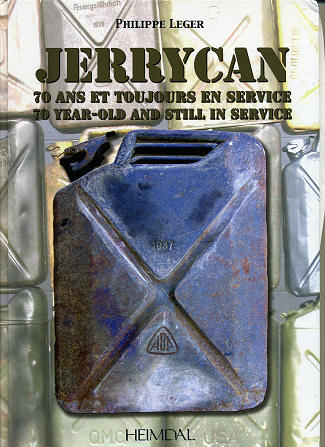 One thing
about MM is that you can count on occasionally running across something rather
esoteric and I think this book fits right in there. The Jerrycan is probably one
of the most lasting items to come out of WWII with as much post-war application
as the Jeep or the C-47.
One thing
about MM is that you can count on occasionally running across something rather
esoteric and I think this book fits right in there. The Jerrycan is probably one
of the most lasting items to come out of WWII with as much post-war application
as the Jeep or the C-47.
Developed in great secrecy for the German Army and
appearing in 1937, the Jerrycan (a name given to it by the British) was
manufactured by a number of companies in several countries during WWII. Though
not the originator of the design, the United States probably build more of these
than all the other countries combined and at a number of different factories.
All had basically the same general design and were developed to hold 20 liters
or 5 gallons of liquid.
The size of the can determined by the fact that a man can relatively
easily carry 20 kg in each hand.
Most of the time these contained gasoline, but they were also used to
transport water and other lubricants. Those holding water were so marked and
were not used for other liquids.
Author Philippe Leger must have a huge collection
of these cans or knows people who do as the book is chock full of photographs of
a rather incredible number of cans, each one slightly different from the other
either in design or in the markings that it carries. I have to tell you that
I've never seen such a comprehensive look at the subject and I'm sure it will
not be surpassed.
The book looks at cans built in Germany, Britain, Italy,
France and the United States. There are also sections on modifications made to
the cans and post-war use. In addition to the myriad images of the cans
themselves, there is a superb collection of period photos showing these items in
use in locations throughout the war zones. Such is the utility of these cans
that they are still being made today and used by armies around the world, though
the material has, in many cases, changed from steel to PVC.
It is a book that I found to be quite interesting
and I know that once you start reading, you will also find it difficult to put
away.
August 2008
Review book courtesy of
Casemate Publishing, where you can order your copy of this and many other superb books.
If you would like your product reviewed fairly and quickly, please contact
me or see other details in the Note to
Contributors.
 One thing
about MM is that you can count on occasionally running across something rather
esoteric and I think this book fits right in there. The Jerrycan is probably one
of the most lasting items to come out of WWII with as much post-war application
as the Jeep or the C-47.
One thing
about MM is that you can count on occasionally running across something rather
esoteric and I think this book fits right in there. The Jerrycan is probably one
of the most lasting items to come out of WWII with as much post-war application
as the Jeep or the C-47.